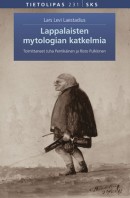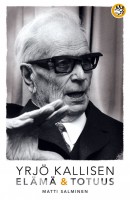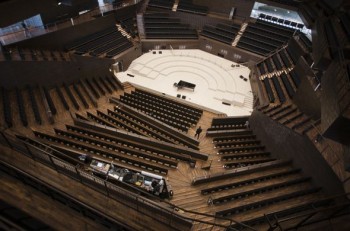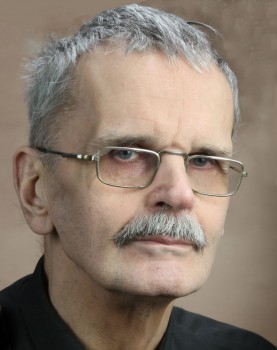Archive for September, 2011
High above the years
23 September 2011 | Fiction, poetry
In Gösta Ågren’s poetry austere aphorisms alternate with concrete observations of life in a small village that was and again is his home, and with portraits of people he has met on his journey in the world. Introduction by David McDuff
Poems from the collection I det stora hela (’On the whole’, Söderströms, 2011)
Father’s hands
(1945)
Father’s hands were like stiff
gloves; a furious
kettle had bewitched them
in his childhood. We ride
from the church’s tall letter
along the river’s long sentence
to the parenthesis of the bridal house,
and the thunder of three hundred hooves
fills the space beneath the clouds.
I saw father driving through
his life with those numbly
gripped reins, and later,
right now, I think of the
life-long body in which a man
comes, is wounded, and goes. More…
In memoriam Herbert Lomas 1924–2011
23 September 2011 | In the news

Herbert Lomas. Photo: Soila Lehtonen
Herbert Lomas, English poet, literary critic and translator of Finnish literature, died on 9 September, aged 87.
Born in the Yorkshire village of Todmorden, Bertie lived for the past thirty years in the small town of Aldeburgh by the North Sea in Suffolk. (Read an interview with him in Books from Finland, November 2009.)
After serving two years in India during the war, Bertie taught English first in Greece, then in Finland, where he settled for 13 years. His translations – as well as many by his American-born wife Mary Lomas (died 1986) – were published from as early as 1976 in Books from Finland.
Bertie’s first collection of poetry (of a total of ten) appeared in 1969. His Letters in the Dark (1986) was an Observer book of the year, and he was the recipient of several literary prizes. His collected poems, A Casual Knack of Living, appeared in 2009.
In England Bertie won the Poetry Society’s 1991 biennial translation award for one of his anthologies, Contemporary Finnish Poetry. The Finnish government recognised his work in making Finnish literature better known when it made him a Knight First Class of Order of the White Rose of Finland in 1987.
To Books from Finland, he made an invaluable contribution over almost 35 years – an incredibly long time in the existence of a small literary magazine. The number of Finnish authors and poets whose work he made available in English is countless: classics, young writers, novelists, poets, dramatists.
Bertie’s speciality was ‘difficult’ poets, whose challenge lay in their use of end-rhymes, special vocabulary, rhythm or metre. He loved music, so the sounds and tones of words, their musicality, were among the things that fascinated him. Kirsi Kunnas’ hilarious, limerick-inspired children’s rhymes were among his best translations – although actually nothing in them would make the reader think that the originals might not have been written in English. A sample: There once was a crane / whose life was led / as a uniped. / It dangled its head / and from time to time said:/ It would be a pain / if I looked like a crane. (From Tiitiäisen satupuu, ‘Tittytumpkin’s fairy tree’, 1956, published in Books from Finland 1/1979.)
Bertie also translated work by Eeva-Liisa Manner, Paavo Haavikko, Mirkka Rekola, Pentti Holappa, Ilpo Tiihonen, Aaro Hellaakoski and Juhani Aho among many, many others; for example, the prolific writer Arto Paasilinna’s best-known novel, Jäniksen vuosi / The Year of the Hare, appeared in his translation in 1995. Johanna Sinisalo’s unusually (in the Finnish context) non-realist troll novel Ennen päivänlaskua ei voi / Not Before Sundown, subsequently translated into many other languages, appeared in 2003. His last translation for Books from Finland was of new poems by Vilja-Tuulia Huotarinen in 2009.
It was always fun to talk with Bertie about translations, language(s), writers, books, and life in general. He himself said he was a schoolboy at heart – which is easy to believe. He was funny, witty, inventive, impulsive, sometimes impatient – and thoroughly trustworthy: he just knew how to find the precise word, tone of voice, figure of speech. He had perfect poetic pitch. As dedicated and incredibly versatile translators are really hard to find anywhere, we all realise our good fortune – both for Finnish literature and for ourselves – to have worked, and enjoyed with such enjoyment, with Bertie.
Poet Aaro Hellaakoski (1893–1956) was not a self-avowed follower of Zen, but his last poems, in particular, show surprisingly close contacts with the philosophy. ‘Secrets of existence are revealed once one ceases seeking them’, the literary scholar Tero Tähtinen wrote in an essay published alongside Bertie’s new Hellaakoski translations in (the printed) Books from Finland (2/2007). Bertie was fond of Hellaakoski, whose existential verses fascinated him; among his 2007 translations is The new song (from Vartiossa, ‘On guard’, 1941):
The new song |
Uusi laulu |
| No compulsion, not a sting. | Ei mitään pakota, ei polta. |
| My body doesn’t seem to be. | On ruumis niinkuin ei oisikaan. |
| As if a nightbird started to sing | Kuin alkais kaukovainioilta |
| its far shy carol from some tree – | yölintu arka lauluaan |
| as if from its dim chrysalis | kuin hyönteistoukka heräämässä |
| a little grub awoke to bliss – | ois kotelossaan himmeässä |
| or someone struck from off his shoulder | kuin hartioiltaan joku loisi |
| a miserable old bugaboo – | pois köyhän muodon entisen |
| and a weird flying creature | ja outo lentäväinen oisi |
| stretched a fragile wing and flew. | ja nostais siiven kevyen. |
| Ah limitless bright light: | Oi kimmellystä ilman pielen. |
| the gift of lyrical flight! | Oi rikkautta laulun kielen. |
Lars Levi Laestadius: Lappalaisten mytologian katkelmia [Fragments of Lapp mythology]
23 September 2011 | Mini reviews, Reviews
 Lappalaisten mytologian katkelmia
Lappalaisten mytologian katkelmia
[Fragments of Lapp mythology]
Toimittaneet [Edited by]: Juha Pentikäinen ja Risto Pulkkinen
Suomentanut [Translated into Finnish by]: Risto Pulkkinen
Helsinki: Suomalaisen Kirjallisuuden Seura / the Finnish Literature Society: 400 p., ill.
ISBN 978-952-222-257-2
€ 28, paperback
The Swedish pastor Lars Levi Laestadius (1800–1861) is known as a preacher who criticised the dead dogma of the church and as the founder of Finland’s largest charismatic sect – although Laestadius did not even live in Finland. He was also a journalist who was active in the temperance movement and wrote a great deal of religious literature; Laestadius may be the best-known Sámi of all time. As well as an ecologist and botanist, he was also a philologist with a knowledge of the dialects of the Sámi language, and as an ethnographer Laestadius studied the history of the Sámi, collecting their beliefs into a system he called the Lapps’ mythology. It is only now that this work has been published in its entirety in Finnish. An expedition funded by Louis Philippe, king of France, in 1838–1840, played a decisive part in the birth of the work: Laestadius was appointed guide to the expedition, and a study of Lapp ‘history’ was commissioned from him. Part of the manuscript was long lost, but in 1946 it was discovered in the library of Yale University.
Translated by Hildi Hawkins
Notes for an unwritten autobiography
15 September 2011 | Fiction, Prose
Extracts from the novel William N. Päiväkirja (‘William N. Diary’, Otava, 2011). Interview by Soila Lehtonen
Paris, 15 November 1897
Constance probably bought this notebook for housekeeping purposes, but forgot it when she left, so I shall take it for my use, and I am not going to tear a single page, because the paper is of good quality and the covers are made of calico. When I write in a small hand there is plenty of room for the text, and when I write in Swedish Constance will not understand, if she chances to see the notebook. She has promised to visit once or twice a week and continue to bring food and do the cleaning (we cleared up the differences of opinion that were related to her departure), even though she has now moved and married a retired officer, having been my housekeeper for nearly 30 years. The laundry she has delegated to Madame L., who lives in this house, although that lady is intolerably nosy and talkative, and she has six smutty children. I have decided to write my autobiography, so that posterity shall receive a full and proper impression of my work. (Let Prof. Schwendener from Berlin and Dr Louis Pasteur be content with minor roles!) I shall not begin until tomorrow, for today I intend to study the specimens of South American lichens Prof. D. has sent if there is enough daylight. More…
Nature boy
15 September 2011 | In the news

Seal signed: Saimaa ringed seal by Erik Bruun
The graphic artist Professor Erik Bruun has been awarded the Luonnotar / National Spirit of Nature Award for 2011.
The prize, established by the Puu kulttuurissa / Wood in Culture Association in 2001 and now worth € 12,000, is awarded bi-annually to Finnish professionals of any field of culture whose work has helped to make the public in Finland and abroad more aware of Finnish culture, heritage and environment.
Erik Bruun (born 1926) – who was the Art Editor of Books from Finland from 1976 to 1989 – is perhaps best known to the public for his numerous posters and advertisements, in particular his nature posters for the Finnish Association for Nature Conservation: the Saimaa ringed seal, the bear, eagles, owls, seagulls and other birds.
Bruun’s interest in nature photography, drawing, etching and lithography have long combined in his work for the Finnish wood processing industry as well as in his illustrative work for magazines and books and in designing postage stamps and banknotes.
A book on his life’s work, Sulka ja kynä. Erik Bruunin julisteita ja käyttögrafiikkaa (‘The quill and the pen. Posters and graphics by Erik Bruun’) by Ulla Aartomaa was published in 2007 (and reviewed in Books from Finland 3/2007). Take a look at his work on his home page.
Matti Salminen: Yrjö Kallisen elämä ja totuus [The life and truth of Yrjö Kallinen]
15 September 2011 | Mini reviews, Reviews
 Yrjö Kallisen elämä ja totuus
Yrjö Kallisen elämä ja totuus
[The life and truth of Yrjö Kallinen]
Helsinki: Like Kustannus, 2011. 271 p., ill.
ISBN 978-952-01-0612-6
€ 27, hardback
Counsellor of Education Yrjö Kallinen (1886–1976) was a Social Democrat politician, a passionate speaker and a pacifist who served for one parliamentary term as an MP and for two years as a cabinet minister. Kallinen was a working-class man who independently acquired a broad general education. His life and thought contain many paradoxes and contradictions. In the Civil War (1918) he received four death sentences, though he tried to act as a peace-broker between the Whites and the Reds. Kallinen avoided the death penalty but suffered a long prison sentence. After the Second World War he became Minister of Defence, though in spite of holding the post he did not abandon his pacifism. Kallinen was also strongly influenced by oriental religions and theosophy, and he is known as an early advocate of vegetarianism. The most important sources for this biography are Yrjö Kallinen’s own writings, many of which have never been published before, and his recently discovered correspondence. The summaries of Kallinen’s interviews for foreign newspapers open up interesting perspectives on recent Finnish political history.
Translated by David McDuff
The sound of music
2 September 2011 | This 'n' that

Helsinki Music Centre: the main hall. Photo: Arno Chapelle
The long-awaited new concert hall, Musiikkitalo (’Music house’, in English Helsinki Music Centre), in front of the Parliament house in the very heart of the city, was opened with a concert (this concert is available at YLE Areena until 30 September) featuring Sibelius and Stravinsky on 31 August.
Musiikkitalo finally provides a new home for two orchestras, the Helsinki Philharmonic Orchestra and the Finnish Radio Symphony Orchestra, as well as for the only Finnish university of music, the Sibelius Academy. It is owned by the Finnish government, the City of Helsinki and Finnish Broadcasting Company. The costs of the building rose from an original estimate of 98 million € in 2005 to 190 million €.
The acoustics designer is the renowned Japanese specialist Yasuhisa Toyota. The building, containing seven halls of various sizes, will provide specialised surroundings for different kinds of music and musicians, acoustics in the existing Finlandia Hall (designed by Alvar Aalto) and other local venues long having proved inadequate or faulty.
The site has remained misused for decades: the brick warehouses, dating from the late 19th and early 20th centuries, were finally abandoned by the national railway company in the 1980s and subsequently occupied by various artists’ and civil organisations, housing popular restaurants and flea markets. Many protests took place when the warehouses were doomed to demolition – and then the buildings were finally destroyed in 2006 in a fire.
The brand new concert hall in Reykjavik, Iceland, is called Harpa (‘Harp’). Wouldn’t it have been nice to give also Musiikkitalo a more exciting name to go by – maybe conduct a straw poll among listeners? Some of the rows of seats (1,704 in all) in the main hall resemble logs floating down in a river, so what about Log jam? Or does that have unfortunate connotations for a project that’s meant to provide Finnish music with a new dynamism?



